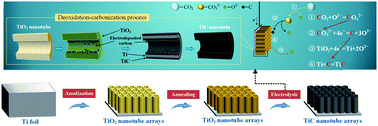Synthesis of TiC nanotube arrays and their excellent supercapacitor performance†
Abstract
Nanostructured metal carbides have numerous applications in catalysis and energy storage. However, directional construction remains a significant challenge. In this work, a novel strategy for the direct synthesis of nanostructured metal carbides using nanostructured metal oxides as the precursor is developed. TiO2 nanotube arrays (TiO2 NTAs) can be successfully transformed into TiC nanotube arrays (TiC NTAs) through electro-deoxidation and carbonization reactions in a low-temperature molten salt. TiC NTAs have a highly oriented and ordered array structure, which shows the advantages of large specific surface area, direct electron transport, and good chemical stability. Here, TiC NTA electrodes and PVA-H3PO4 electrolyte gel were assembled into a flexible quasi-solid-state supercapacitor to characterize their energy storage performance. The results show that the TiC NTA electrodes exhibit a high areal capacitance of 53.3 mF cm−2, excellent cycling stability, and mechanical flexibility. Moreover, the energy densities can reach 4.6 μW h cm−2 at a power density of 78.9 μW cm−2. This work provides a new strategy for the directed synthesis of nanostructured metal carbides and demonstrates the energy storage application potential of TiC NTAs. It is expected that this work will contribute to the development of the synthesis and application of nanostructured metal carbides.



 Please wait while we load your content...
Please wait while we load your content...